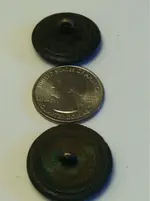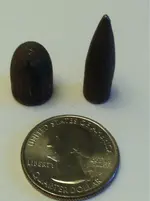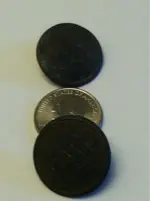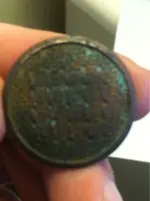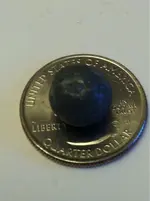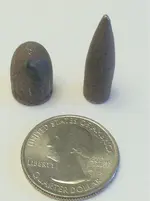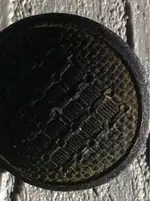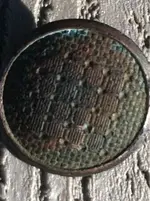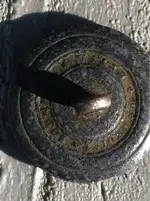0121stockpicker wrote:
> So these are the bullets that no longer have the cartridge - ie they have been fired?
Yes, firing is the main reason bullets which originally came in a metal cartridge are found without the metal cartridge-casing. But occasionally, somebody removed the bullet from the casing, perhaps to get the gunpowder. In particular, we knppw civil war soldiers soldiers sometimes did that because gunpowder helps you start a campfire when all you've got is wet firewood.
That being said... your new photo shows rifling-marks on your .45-caliber copper-jacketed bullet. The rifling-marks (ridges running up from the bullet's base towards its nose) are made by the rifling-grooves in the gunbarrel when the bullet gets fired. Your photo doesn't show rifling-marks on the 30-caliber bullet, but perhaps your eyes can spot them in real-life if the rifling-marks are there.
About your buttons:
The new photos show what I suspected seeing in your previous photos... a "backmark" consisting of raised lettering inside a depressed channel. Button-collectors call it an RMDC (Raised-Mark-in-Depressed-Channel) backmark. On 2-piece and 3-piece (hollow) buttons, an RMDC-type backmark means the button was manufactured sometime between the 1830s and 1860s (although a very few are from the 1870s).
A button's backmark usually shows a name of a button-making company or a button seller. There is a collectors' reference-book which tells the time-period of such companies, to help us date the button.
So, I suggest you do some very careful additional cleaning to reveal the name in the backmark of your buttons. The method I've used for that is to dip the tip of a toothbrush into household Ammonia-based cleaner such as Top Job, or "straight" (pure) Ammonia ...or as an alternative, lemon-juice. Put a few drops on the button's back, wait only a minute or two (no more than that), and gently scrub the button's back with the toothbrush's bristles. Then rinse the button thoroughly with water. If necessary, repeat the cleaning.
Note, "straight" Ammonia is a stronger chemical than Top Job or lemon-juice, so do not let pure Ammonia stay on the button for more than two minutes per cleaning. Top Job and lemon-juice take longer to work (usually about 5 minutes).
If the cleaning reveals any of the letters in the backmark, tell us what they are. We "long-experienced" button-collectors can often decipher a backmark without knowing what every letter in it is. For example, in a recent discussion in the What-Is-it forum, a digger could only read the letters "drick" in his dug button's backmark. I knew that it meant "Kendrick & Co." ...which enabled me to date the button to strictly the 1830s.



